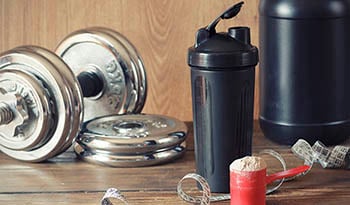How Much Protein Do You Need for Weight Loss?
DISCLAIMER:This blog does not intend to provide diagnosis...
- In this article:
- Why Should We Manipulate Protein Intake?
- How to Determine Protein Intake With Weight Loss
- 3 Ways to Increase Protein Intake
- 7 Good Sources of Protein

Protein intake is one of the most important variables to pay attention to and manipulate when in weight loss phases. This macronutrient plays a large role in the body and is especially important when available energy is limited due to its ability to help preserve muscle and lean body mass.
In this article, we’re going to discuss how to manipulate protein intake when in weight loss phases. How much should you increase it? What’s a good protein intake goal to aim for? These are all questions we’ll cover in this article.
Why Should We Manipulate Protein Intake?
Generally speaking, weight loss phases will be spurred for two reasons, 1) to lose weight, and 2) to decrease body fat. When we’re manipulating caloric intake and decreasing it, the body will have less energy available to utilize for growth, recovery, and lean mass preservation.
Losing Weight
When it comes to the first goal of weight loss on the scale, your daily caloric intake will play a larger role in progress. As we progress through our dieting phases and our energy expenditure continues to decrease we’ll start to lose body fat and muscle mass at various rates which will reflect lower bodyweight numbers.
What Influences Weight-loss?
Weight-loss rates can vary from individual to individual and will be based on a variety of factors and some of these include:
- Your Starting Point (current weight)
- Your Current and Manipulated Nutritional Intake (your caloric deficit size)
- The Length of Your Weight Loss Phase
- Current Levels of Lean Muscle Mass (how much muscle do you have?)
During weight loss phases, there’s no perfect one-size-fits-all formula for weight loss on the scale. The factors above should be considered and if you’re not “losing” at a rate that you like, then remain objective and realistic with your expectations.
Losing Body Fat
Everyone will have varied rates of weight loss and if we can focus on the important details and stay consistent, then we’ll set ourselves a better means to see long-term gains. The rate at which we lose body fat and muscle will be individual and a good goal to remain cognizant of during weight loss phases is to mitigate and limit how much muscle we’re losing, which brings us to our second goal—body fat loss.
Body fat loss can be a bit more finicky than weight loss and will require strategy as everyone loses body fat at different rates and the areas in which we lose body fat will also vary. This is where manipulating training and protein intake can be important and we’ll discuss how to shift the latter below.
Remember, muscle helps the body burn more calories on a daily basis and supports countless bodily functions. This is why the preservation of lean muscle mass should be at the forefront of everyone’s weight loss phase.
Basically, if we can progress through a weight loss phase and work our hardest to preserve lean muscle mass, then we can set ourselves up for future success. A higher lean body mass will yield countless benefits and these will be individual based on your lifestyle.
How to Determine Protein Intake With Weight Loss
As a general rule of thumb, you’ll need to increase protein intake as you progress further into weight loss phases. When caloric intake continues to decrease, protein intake should continue to increase in an effort to preserve lean muscle mass.
This shift will then result in the manipulation of the other macronutrients carbohydrates and fat. As you increase protein intake this is normal as you’ll have to “make room” for the additional calories coming from protein so you can still hit your current deficit goal.
When Starting Out a Weight Loss Phase
Once you’ve decided to initiate a weight loss phase, it’s important to establish a protein intake that is both realistic for your dietary means and sets you up for success.
As a starting point, research generally recommends consuming between 2.3-3.1g per kg of lean body mass (so that means total body weight minus fat mass). This amount will ensure you’re consuming enough protein to preserve lean muscle mass while working with fewer calories on a daily basis.
Then, as you progress through your weight loss phase, you’ll need to increase your protein intake accordingly. Some factors to stay cognizant of are:
- Body Fat Levels
- Current Protein Intake
- Lean Body Mass: How much muscle you currently have.
- Length of Your Diet: Also, how long you've been in a deficit.
The easiest way to scale protein intake when in weight loss phases is to track body fat, then shift protein accordingly. As your body fat decreases, protein intake should increase.
You can track body fat by a variety of means and a good bet could be to check in with your body fat levels in a consistent means every 2-3 weeks.
Shifting Protein Intake Further
We’ve already stated that you’ll need to increase protein intake as body fat levels decrease, but by how much?
As a general rule of thumb, you can use the following ranges to help shift your protein intake further.
For men who have 15% body fat or lower and women who have a body fat of 23% or lower, then a good rule of thumb would be to explore an intake of 2.6g-3.1g per kg of lean body mass.
Based on your initial intake, if you noticed your body fat decrease and fell within or below the body fat numbers above, then you would select a slightly higher protein intake. So, if you started with a 2.3g intake, then moving to 2.5/2.6g could be a good call. Remember, you’ll need to select a number that’s realistic for your daily intake and needs.
For those with higher body fats, you can utilize a slightly lower range. A good range for men with 16% body fat and higher and women with 24% and higher could be 2.5-2.8g per kg of lean body mass. Again, scale your intake based on the factors discussed above.
3 Ways to Increase Protein Intake
If you’re in the process of increasing your protein intake, then you might be wondering how to do so in a realistic means. Below, you’ll find three of my favorite tips for those in weight loss phases to increase protein intake throughout their day in a feasible means.
- Spread Out Intake: One of the easiest ways to consume more protein is to spread out intake throughout the day. This means that every meal and snack will have some level of protein content to help you hit your daily goals.
- Try Protein Powder: Protein powders can be incredible tools for increasing protein intake. Shakes will usually be lower in calories and packed with quality protein. This is great because it can award you with more calories for other macronutrients to help you pursue your lifestyle and performance goals.
- Consume More Around Workouts: At times, higher protein intakes can feel tedious to consume. To counter this, try to consume higher amounts in the meals that follow your workout. This will help you recover and hit your daily intake while in a time frame of heightened desires to eat.
When working through weight loss phases, it’s important to increase protein intake as body fat (and body weight) decreases. As body fat decreases, we want to preserve as much lean muscle mass as possible because this will set us up for future success in gaining, maintaining, and weight loss phases.
7 Good Sources of Protein
If your goals are overall better health and weight loss, some protein sources are better than others. Also, if you have dietary restrictions, some forms of protein may be better than others. Here are some of the best protein sources:
- Protein powders: If you consume dairy, you can opt for a whey protein or casein protein. If you are a vegan or lactose-intolerant, you can opt for a plant-based protein powder.
- Bone broth
- Protein bars: Look for brands that don’t contain added sugars.
- Beans and lentils
- Nuts and seeds
- Seafood
- Organic meats and poultry
Should You Supplement with Protein? Here are 3 Key Benefits: Read more.

 By Jake Boly, CSCS
By Jake Boly, CSCS


